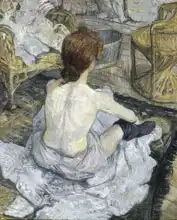About this finishing
Print. The image is printed on the top quality 10-ink HP Z9PS printer on HP matte 270 g / m2 paper. You can choose any size to an accuracy of 1 cm. A margin of 5 cm around the image is added to the size of the motif.


You can find a detailed description about our finishings
here.
La Toilette (Toulouse-Lautrec)
Date:
1896Medium:
oil on boardLocation:
Musee d'Orsay, Paris, France"La Toilette" by
Henri de Toulouse-Lautrec is an oil painting he created around 1889. This work is part of his series of portraits that capture intimate moments in the lives of Parisian cabaret performers and prostitutes with whom he became closely acquainted.
In the painting "La Toilette" we can see a woman who is preoccupied with adjusting her appearance. Cabaret
dancers and prostitutes were frequent subjects in Toulouse-Lautrec's artistic work. The painter was fascinated by the nightlife and the people who inhabited it, and this is reflected in his artwork.
In this particular image, we can observe how he is captured before a performance or before a meeting with a client. The artist highlights the intimacy and personal moments of these women's lives without idealizing their situation. Toulouse-Lautrec's approach to these subjects was controversial in his time, but today his works are valued for their authenticity and ability to capture the atmosphere of fin de siècle Parisian life.
Toulouse-Lautrec painted picture La Toilette (Toulouse-Lautrec) in 1896. Prevailing color of this fine art print is vivid and its shape is portrait. This art piece is located in Musee d'Orsay, Paris, France. This image is printed on demand - you can choose material, size and finishing.
Henri de Toulouse-Lautrec (1864-1901). His full was name Henri Marie Raymond de Toulouse-Lautrec-Monfa. French painter, illustrator and printer. His work includes paintings and hundreds of posters. It is renowned for its elegance and provocativeness. Together with
Cézanne, van Gogh, Gauguin, he was one of the most famous painters of
Post-Impressionism. He suffered health problems (a rare genetic disorder is named after him). He warded of depression and gloom with alcohol, to which he was addicted. In twenty years, he painted 737 paintings, 5084 drawings and sketches and hundreds of posters. He was influenced by
Impressionism - especially
Manet and
Degas. He was a master of group paintings from the artistic scene, nightlife, bars and cafés. He painted expressions and attitudes of the characters in the paintings with great detail and used contours and long brush strokes.


